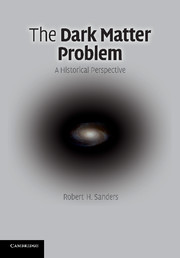Book contents
- Frontmatter
- Contents
- Acknowledgements
- 1 Introduction
- 2 Early history of the dark matter hypothesis
- 3 The stability of disk galaxies: the dark-halo solution
- 4 Direct evidence: extended rotation curves of spiral galaxies
- 5 The maximum-disk: light traces mass
- 6 Cosmology and the birth of astroparticle physics
- 7 Clusters revisited: missing mass found
- 8 CDM confronts galaxy rotation curves
- 9 The new cosmology: introducing dark energy
- 10 An alternative to dark matter: modified Newtonian dynamics
- 11 Seeing dark matter: the theory and practice of detection
- 12 Reflections: a personal point of view
- Appendix Astronomy made simple
- References
- Index
2 - Early history of the dark matter hypothesis
Published online by Cambridge University Press: 05 July 2014
- Frontmatter
- Contents
- Acknowledgements
- 1 Introduction
- 2 Early history of the dark matter hypothesis
- 3 The stability of disk galaxies: the dark-halo solution
- 4 Direct evidence: extended rotation curves of spiral galaxies
- 5 The maximum-disk: light traces mass
- 6 Cosmology and the birth of astroparticle physics
- 7 Clusters revisited: missing mass found
- 8 CDM confronts galaxy rotation curves
- 9 The new cosmology: introducing dark energy
- 10 An alternative to dark matter: modified Newtonian dynamics
- 11 Seeing dark matter: the theory and practice of detection
- 12 Reflections: a personal point of view
- Appendix Astronomy made simple
- References
- Index
Summary
Prehistory
Dark matter, in an astronomical sense, is introduced to explain the difference between how objects in the sky ought to move, according to some preconceived notion, and how they are actually observed to move. In that sense, the first application of this concept was employed, as one might expect, by the Greeks. In the fourth century BC Eudoxus of Cnidus, a student of Plato, proposed that the stars and the Sun were attached to transparent spheres with the Earth at the center. The spheres rotated about the Earth: the outer “stellar” sphere once per day, and the inner “solar” sphere also once per day with an additional annual motion with respect to the stellar sphere. The spheres were not actually dark but transparent, so that we could see the stellar sphere through the solar sphere. The spheres did not possess the attribute of mass – or weight – so perhaps it is not proper to speak of them as matter. But they were certainly unseen constructs proposed to explain the observations. The most famous student of Plato, Aristotle, increased the number of spheres to 55 to account for planetary motion, and he seemed to believe in the actual reality of these spheres.
The system was codified by Ptolemy in the second century AD and reigned supreme for about 1300 years. By the time of Copernicus the entire construction had become very complex with spheres on spheres and off-center spheres in order to explain the increasingly precise observations of planetary motions.
- Type
- Chapter
- Information
- The Dark Matter ProblemA Historical Perspective, pp. 11 - 25Publisher: Cambridge University PressPrint publication year: 2010



